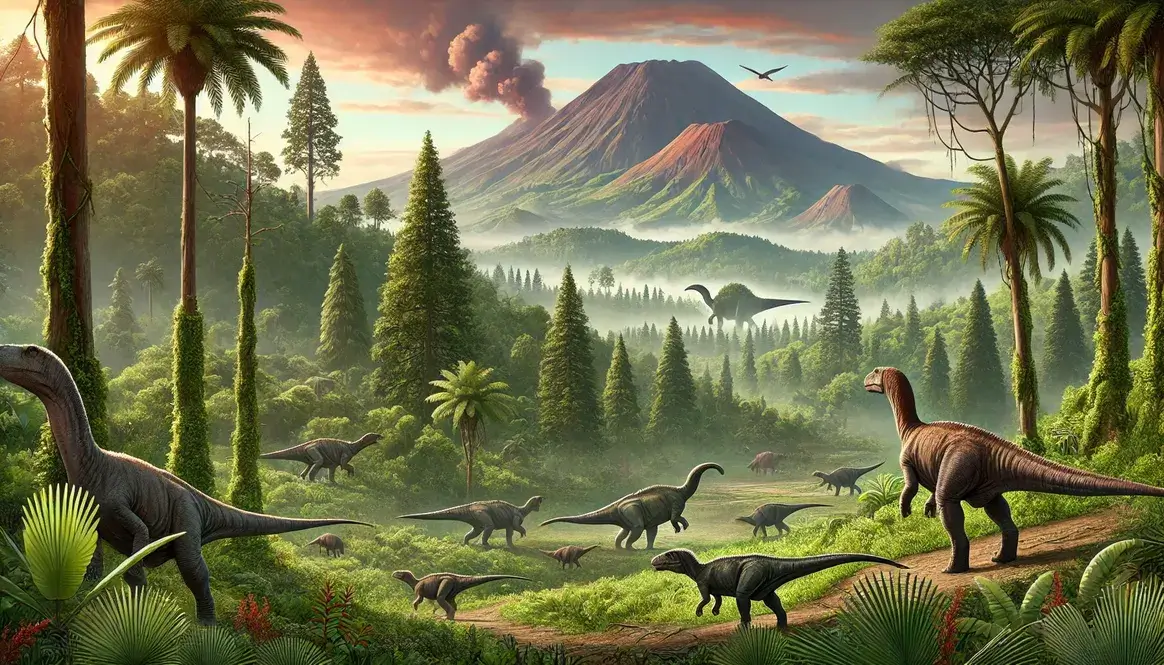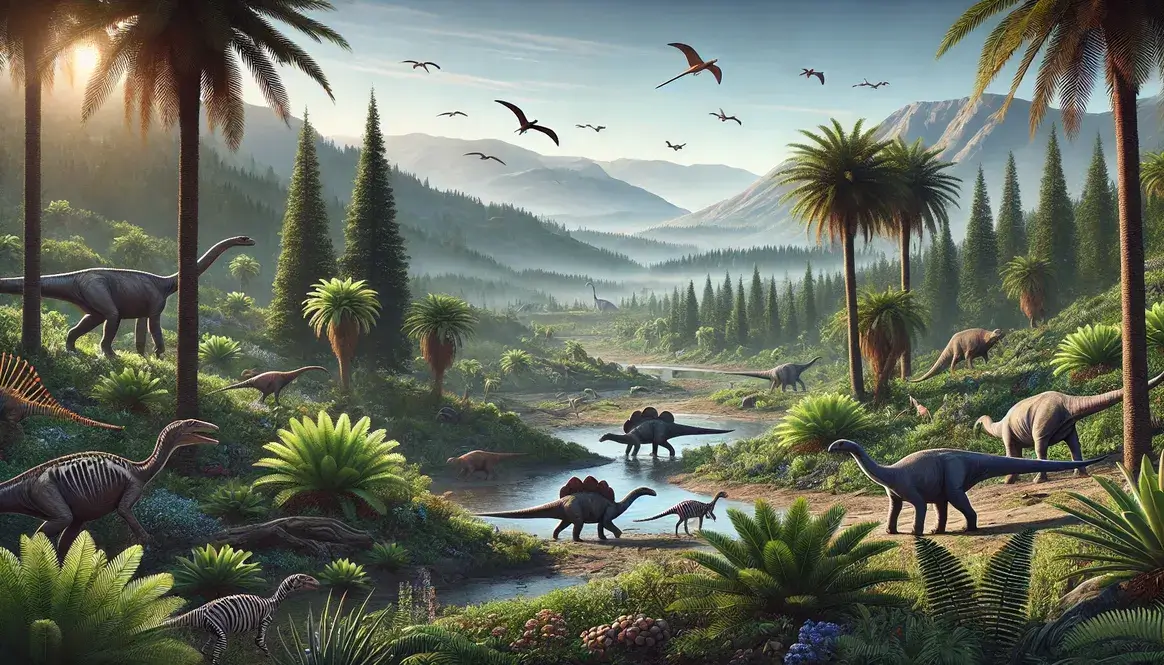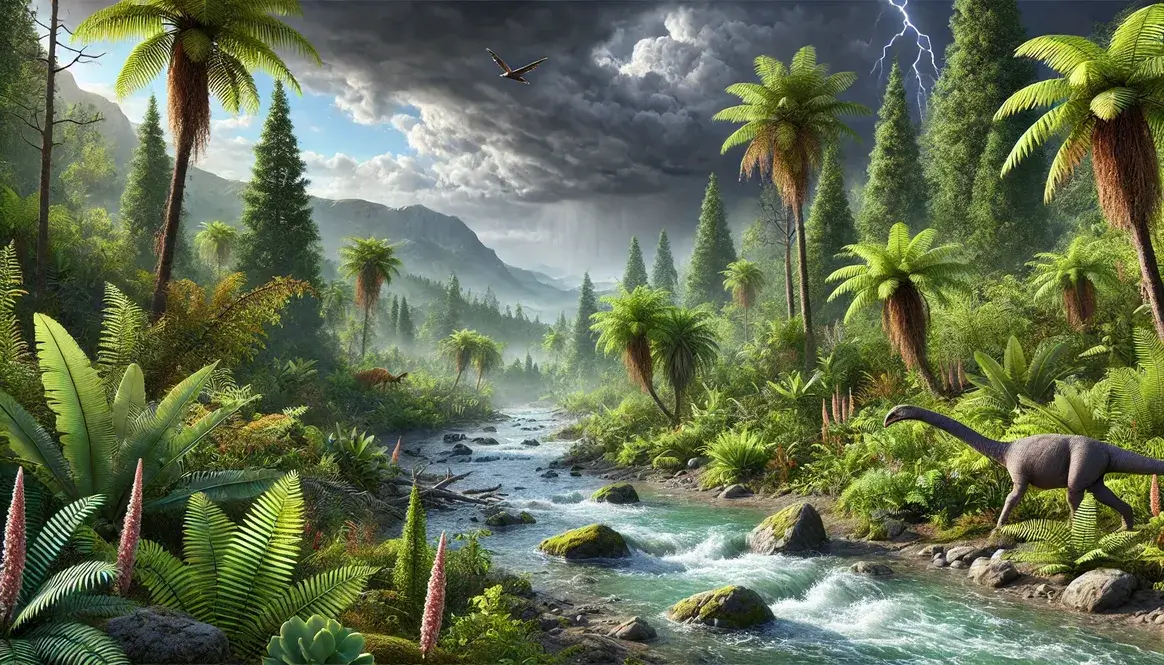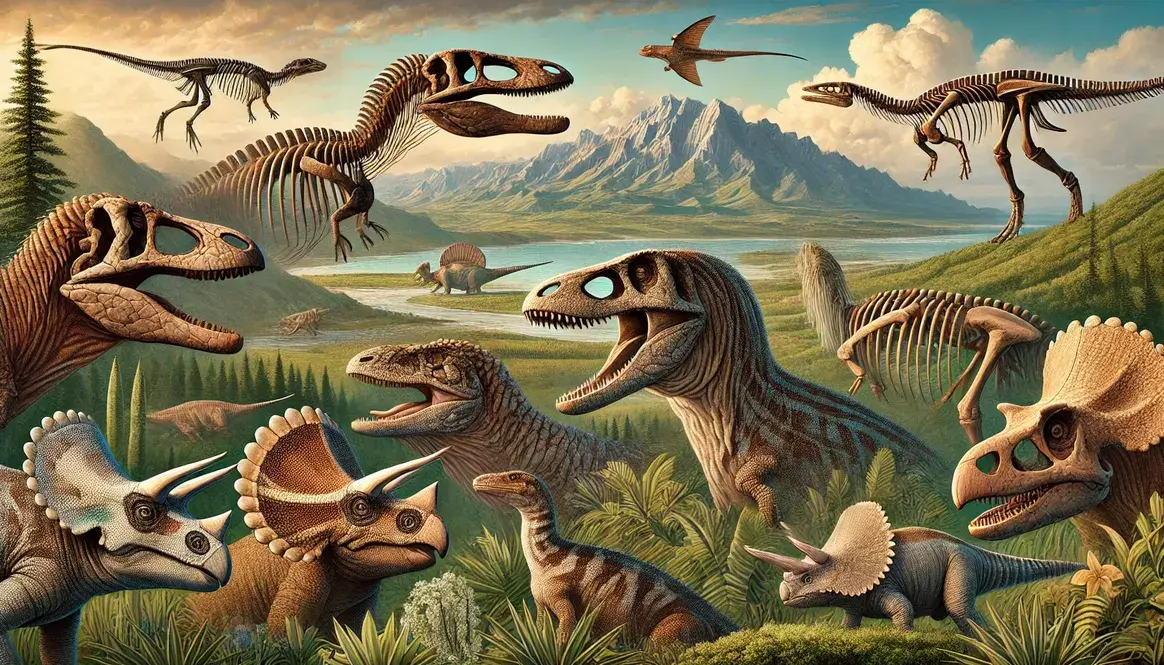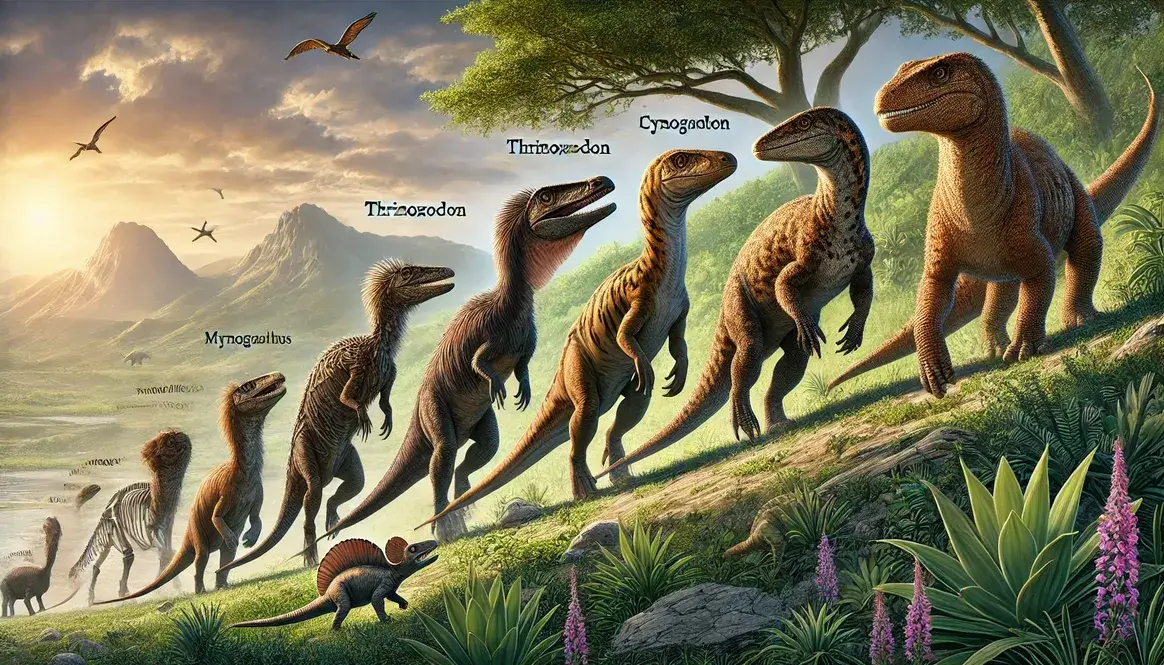We’re about to zoom back 252 million years to explore the Triassic climate – a wild ride through one of Earth’s hottest eras. Get ready to sweat as we uncover how our planet transformed from a barren wasteland into a steamy greenhouse world.
The Early Triassic: A World Recovering from Catastrophe
Imagine stepping out of your time machine into a world that’s just survived the worst mass extinction in Earth’s history. Welcome to the early Triassic! The Permian-Triassic extinction event wiped out a whopping 95% of marine species and 70% of land vertebrates.
The climate? It was like walking into a blast furnace. Global temperatures soared 6-8°C above today’s levels. Oceans were as warm as a hot tub, and on land, it was scorching hot and bone-dry in many areas. Not exactly ideal vacation weather!
But life is stubborn. Slowly but surely, plants and animals began to recover. As vegetation spread, it started to cool things down a bit. More plants meant more water vapor in the air, leading to more rainfall. It was like Earth was turning on its own air conditioning system!
| Early Triassic Climate Features | Description |
|---|---|
| Global Temperature | 6-8°C above present |
| Ocean Temperature | Up to 40°C in tropical areas |
| Rainfall | Initially low, gradually increasing |
| Vegetation | Sparse at first, slowly recovering |
Mid-Triassic Climate Shifts: The World Warms Up
As we move into the middle Triassic, things start heating up again. It’s like Earth decided to crank up the thermostat! Global temperatures continued to rise, with some scientists estimating they were about 3°C warmer than in the early Triassic.
Why the warm-up? One big culprit was carbon dioxide (CO2). Volcanic eruptions were pumping this greenhouse gas into the atmosphere like there was no tomorrow. And guess what? More CO2 meant even more heat trapped in the atmosphere.
But it wasn’t all bad news for life on Earth. The warmer temperatures and higher CO2 levels were like a growth serum for plants. Forests began to spread, and new plant groups emerged. This period saw the rise of conifers and other gymnosperms, which would dominate the landscape for millions of years.
The seasons also became more pronounced during this time. Near the poles, there were now distinct warm and cool periods, though it was still much warmer than today. Imagine a world where even the poles were green and lush!
Late Triassic: Peak of the Greenhouse World
Hold onto your hats, folks, because the late Triassic was when things really heated up! This was the peak of the Triassic period greenhouse world, with global temperatures reaching their highest levels.
How hot are we talking? Well, the average global temperature was about 5°C warmer than today. That might not sound like much, but it’s enough to completely change the face of the planet. The poles were ice-free and covered in forests. Deserts expanded in the interiors of continents. It was a world that would seem alien to us today.
Extreme weather events became more common. Mega-monsoons drenched the coasts of Pangaea, while the interior of the supercontinent suffered intense droughts. It was a time of climate contrasts!
| Late Triassic Climate Features | Description |
|---|---|
| Global Temperature | ~5°C above present |
| Polar Regions | Ice-free, forested |
| Equatorial Regions | Extremely hot and humid |
| Weather Events | Intense monsoons and droughts |
But even in this global hothouse, there were regional variations. The equatorial regions were scorching hot and humid, like a steam room turned up to 11. The mid-latitudes were warm and seasonal, while the polar regions enjoyed mild, frost-free conditions year-round.
Climate Zones of the Triassic
Let’s take a world tour of the Triassic! Imagine hopping into a time-traveling hot air balloon and floating across different climate zones. Buckle up, it’s going to be a steamy ride!
Equatorial Regions: Hot and Humid
If you thought today’s tropics were sticky, you haven’t seen anything yet! The Triassic equator was like a sauna cranked up to maximum. Temperatures averaged around 35°C (95°F) year-round, with high humidity thanks to increased evaporation from warm oceans. Intense rainfall was common, with monsoon-like downpours drenching the landscape.
Evidence from fossil plants and sediments paints a vivid picture of these ancient climates:
- Fossil leaves with “drip tips” – pointy ends that helped water run off in rainy environments
- Thick layers of coal, formed from lush tropical vegetation
- Red bed deposits, indicating hot, oxidizing conditions
Mid-Latitudes: Warm and Seasonal
Moving away from the equator, things cool down… but just a little! The mid-latitudes experienced warm summers with temperatures reaching 30°C (86°F) or higher, while winters were mild, rarely dropping below freezing. Unlike the constant rainfall at the equator, these regions had distinct wet and dry seasons.
Think of the warmest parts of the Mediterranean, but turned up a notch. Places like southern Spain or northern Africa give us a taste of what mid-latitude Triassic climates might have been like.
Polar Regions: Mild and Ice-Free
Here’s where things get really weird. Forget everything you know about polar climates! The Triassic poles were ice-free year-round, with average temperatures above freezing even in winter. Only in the latest Triassic did short-lived winter snow become possible.
These mild conditions created unique ecosystems:
- Forests grew all the way to the poles
- Dinosaurs roamed polar regions, though these evolved later in the Mesozoic
- Plants adapted to long periods of darkness during polar winters
Factors Shaping Triassic Climate
Now, let’s dive into the “why” behind this hothouse world. What turned Earth into a planetary greenhouse?
The Supercontinent Pangaea
Imagine all of today’s continents smooshed together into one giant landmass. That was Pangaea! This super-sized continent had a massive impact on climate, creating huge temperature extremes between coast and interior, expanding deserts in the continental heart, and reducing the moderating effect of oceans on land temperatures.
Monsoon patterns were dramatic, with mega-monsoons drenching Pangaea’s coasts while the interior suffered extended droughts. It was a world of climate extremes!
Volcanic Activity and CO2 Levels
The Triassic was a time of intense volcanic activity, playing a big role in shaping the climate. Two major events stand out:
- Siberian Traps: The tail end of this massive eruption from the Permian continued into the early Triassic.
- Central Atlantic Magmatic Province (CAMP): This enormous volcanic event marked the end of the Triassic.
These eruptions pumped massive amounts of CO2 into the atmosphere, creating a greenhouse effect on steroids. More CO2 meant more heat trapped, leading to more warming, which released even more CO2 from the oceans. Talk about a vicious cycle!
Ocean Circulation Patterns
The oceans weren’t just sitting there looking pretty. They were major players in the Triassic climate game! With Pangaea surrounded by a single global ocean (Panthalassa), ocean currents behaved very differently from today.
A strong circumpolar current in the south and restricted circulation in the Tethys Sea (between Pangaea’s arms) led to enhanced heat transport to polar regions. This contributed to the ice-free poles and affected rainfall distribution across Pangaea.
The interplay of these factors created the unique Triassic climate, setting the stage for the rise of dinosaurs and the dramatic changes that would follow in the Jurassic period.
Life in a Greenhouse World: Adaptations to Triassic Climate
The Triassic hothouse wasn’t just a challenge for life – it was an opportunity for innovation. Let’s explore how plants and animals adapted to this steamy world.
Plant Adaptations
The Triassic saw the emergence of new plant groups that thrived in warm climates. Conifers, ginkgoes, and cycads became the dominant plants, replacing the Permian-era seed ferns. These plants were better equipped to handle the hot, dry conditions of the Triassic.
Changes in leaf structures and water management were crucial adaptations:
- Smaller leaves: Many plants developed smaller leaves to reduce water loss.
- Thick cuticles: Waxy coatings on leaves helped prevent excessive evaporation.
- Deep root systems: Plants evolved longer roots to access water deep underground.
Some plants even developed the ability to close their stomata (leaf pores) during the hottest parts of the day, a trick that modern desert plants still use!
Animal Adaptations
Triassic animals had to get creative to beat the heat. Here are some of their clever adaptations:
- Nocturnal behavior: Many animals became active at night to avoid the scorching daytime temperatures.
- Burrowing: Some creatures took to living underground where it was cooler.
- Improved cooling systems: Early dinosaurs may have developed more efficient respiratory systems to help cool their bodies.
Physiologically, some animals likely developed the ability to concentrate urine, reducing water loss – a trait seen in modern desert animals. Others may have developed lighter-colored skin or fur to reflect more sunlight.
Climate-Driven Events: The Carnian Pluvial Episode
About 230 million years ago, the Triassic climate took an unexpected turn. Welcome to the Carnian Pluvial Episode – a period of increased rainfall that lasted for about 1-2 million years.
This wet spell was likely caused by an increase in volcanic activity, which pumped more water vapor into the atmosphere. The result? A global increase in humidity and rainfall, turning many arid regions into lush wetlands.
The impacts were far-reaching:
- Expansion of conifer forests
- Diversification of dinosaurs
- Major turnover in marine life
This climate shake-up may have set the stage for dinosaurs to become the dominant land animals. Talk about making the most of a rainy day!
End-Triassic Climate: Prelude to Another Mass Extinction
As the Triassic drew to a close, the climate began to destabilize. Temperatures swung wildly, and extreme weather events became more common. It was as if Earth’s thermostat had gone haywire.
What caused this climate chaos? The prime suspect is the Central Atlantic Magmatic Province (CAMP), one of the largest volcanic events in Earth’s history. This massive eruption:
- Released enormous amounts of CO2 and sulfur dioxide
- Caused rapid global warming
- Led to ocean acidification
The result was devastating. Up to 76% of all species on Earth went extinct, including many of the Triassic’s most successful animals. But as always, life found a way. The survivors adapted to the new conditions, setting the stage for the Jurassic world to come.
As we transition to the Jurassic climate, we see a world that’s still warm, but not quite as extreme as the Triassic. The Jurassic period would bring its own climate challenges and opportunities.

